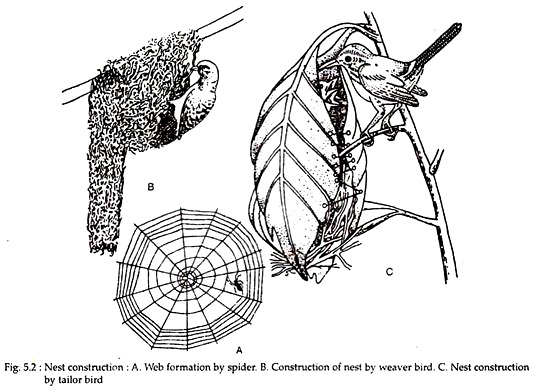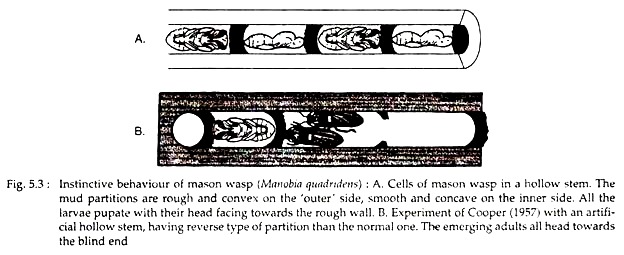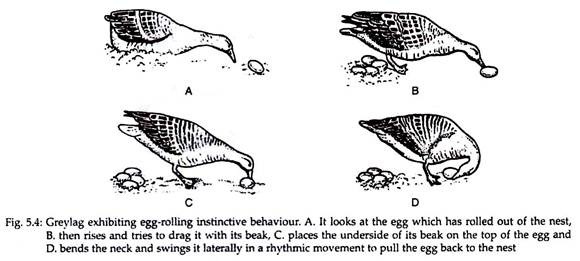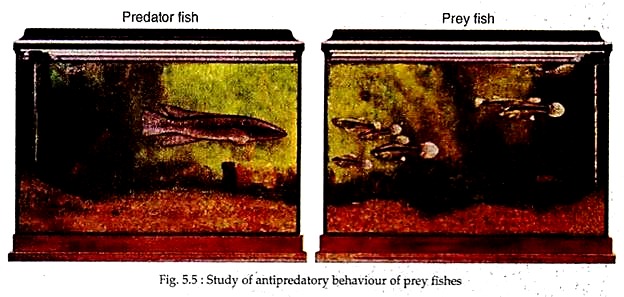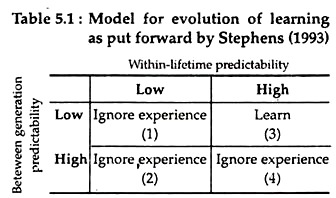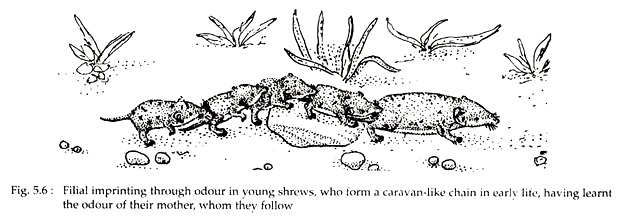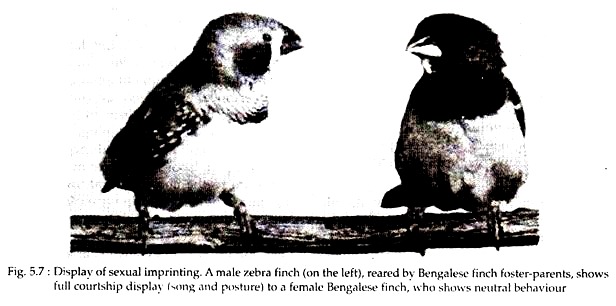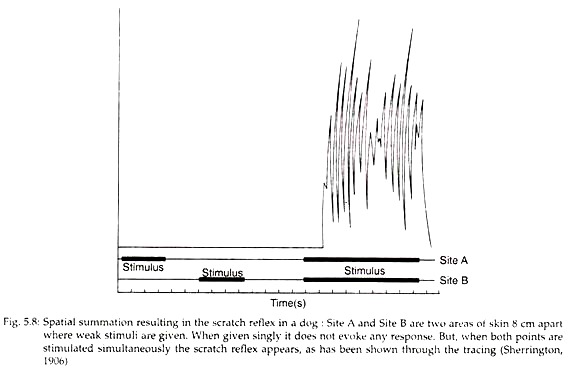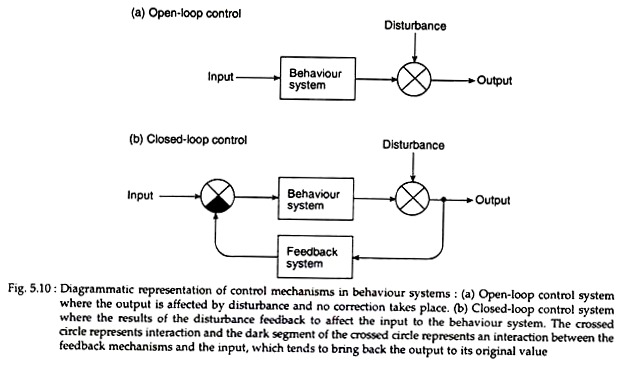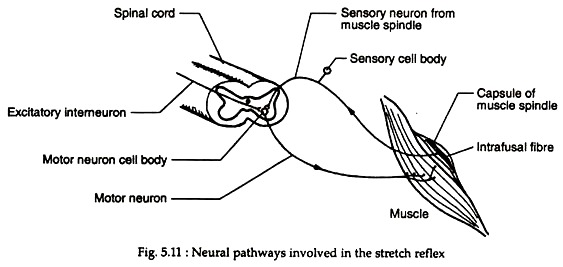The following points highlight the three categories of behavioural pattern of animals. The categories are: 1. Instinctive Behaviours or Fixed Action Pattern (FAP) 2. Learning Behaviour 3. Complex Behaviour.
Category # 1. Instinctive Behaviours or Fixed Action Pattern (FAP):
Instinctive Behaviours are genetically inherited characteristics that impel animals to behave in a certain fixed way. It is also referred to as Fixed Action Pattern (FAP) or Innate Behaviour or Inborn Behaviour or Inherent Behaviour. Instinct is generally described as patterns of inherited pre-set behavioural responses which develop along with the developing nervous system.
It is a familiar behaviour which evolves gradually over the generations by selection, to match an animal’s behaviour to its environment. It may be defined as a behaviour which does not require learning or practice, but which appears spontaneously at the first instance of its need.
Although this definition is of a negative kind, it emphasises the other familiar way in which behaviour can become matched to circumstances. In the latter case, animals do not have any present responsiveness, but are able to modify their behaviour in the light of individual experience. The terms Inherited Adaptations and Acquired Adaptations are sometime used to emphasise the source.
ADVERTISEMENTS:
In the animal kingdom, there are a number of behavioural patterns which are depicted in the genes. To name a few — the courtship display and mating in most animals, feeding patterns, nest building, parental care, singing, wings cleaning, territoriality and aggression, construction of web by spiders (Fig. 5.2A), construction of nest by birds etc..
A few common examples are:
1. During the breeding season a peacock starts dancing as soon as it sees a peahen. The dancing act is not learnt by watching.
ADVERTISEMENTS:
2. A weaver bird never learns to construct a nest (Fig. 5.2B). It simply knows it.
3. A tailor bird brings two leaves together and stiches them with a long flexible grass (Fig. 5.2C) and then cushions the bottom with soft grasses, where it lays her eggs. This vital information were passed on to them through the genes of their parents.
4. Bees do not learn to build their hive, this property is acquired genetically.
Another very interesting example of instinctive behaviour or FAP is provided by the Mason wasp (Manobia sp). A female wasp, after emerging from her cell, has a brief moment of interaction with another wasp when she mates with a male. Later, totally on her own, she selects a hollow stem and builds at its inner end, a partition of mud mixed with her saliva.
ADVERTISEMENTS:
Close to this partition she lays an egg. Thereafter, she hunts for caterpillars which she lightly paralyses with her sting. She carries 5-8 of them to the cell which would act as future food supply for the larva when it hatches. After being satisfied, she builds another partition sealing off the egg with its food supply.
She then lays a second egg beyond the second partition, provides it with future food supply and seals it off. The process continues till 8-10 cells are constructed in line along the cavity of stem, until the female has reached the outside. She then plugs the outside end with mud (Fig. 5.3) and flies off to seek another stem for more construction of cells.
The female wasp carries out this elaborate series of behaviour patterns in total isolation and that too in her short lifespan of a few weeks. It is, thus, not possible for her to acquire everything from scratch, through trial and error method, and that too in her tight schedule. Thus, she has to rely on preset unlearnt responses.
Cooper (1957), while studying this particular wasp species (Manobia quadridens), made some fascinating observations. While examining a stem, he observed that prior to the emergence into the adult; all the pupae were oriented with their heads facing the open end.
Normally, the outermost pupae (although derived from later-layed eggs), emerge out of the stem first breaking through the partition and leaving a clear passage for other siblings, coming from deeper in the stem. Under no condition do they ever make the wrong choice of end.
How does the pupae make the correct choice of end? Cooper observed that there was no possibility that they detected light or used gravity or oxygen concentration as a cue. The emerging pupated adults rely heavily on information left behind by their mother.
While building the partition between the cell the female wasp retreating outwardly, leaves the inner side of the partition as rough mud, whilst the outer side she smooths into a concave form (Fig. 5.3A).
Cooper then made an artificial hollowed stem in which he used glass paper to make partitions. The partitions were reversed in orientation (Fig. 5.3B) and, as a result, emerging adults headed ‘inwards’ towards the blind end. Thus, Cooper was able to show unequivocally that the larvae used just the characteristics of concavity and smoothness versus roughness to orient itself.
ADVERTISEMENTS:
Such information is obviously passed from one generation of wasps to its offspring genetically. Under no conditions does neither the mother wasp’s action nor the response of the larvae can rely on experience. Instinct is understood as an innate behaviour mechanism that impel animals to behave in a certain fixed way. The notion of Fixed Action Pattern was formulated by Konrad Lorenz (1958).
Sign stimulus or releaser:
FAP is a specific and stereotyped sequence of activities that are triggered by particular stimulus called sign stimulus or releaser. Definite sign stimulus or releaser works and initiates instinctive acts.
For example:
1. The red belly in the males of three-spined stickleback fish is one specific sign stimulus, responsible for releasing territorial defence and other reproductive activities.
2. The red spot present on the bill of herring gull is pecked by its chicks which acts as a sign stimulus. This induces the parent to regurgitate food called crop milk.
3. When the parent of song birds alights on the nest with food in their beak, it creates a jerk. This acts as a sign stimuli for the begging behaviour of the chicks.
Occasionally, when there is total absence of flying insects, insectivorous birds may fly out and go through all the motions of catching, killing and devouring an imaginary insect. Such occasional responses may occur in the absence of appropriate stimulus called vacuum behaviours.
Components of FAP:
Instinct or Fixed Action Pattern as a rule shows two components:
(a) Stereotyped or consummatory action, and
(b) Appetitive or searching behaviour.
(a) Stereotyped or consummatory action:
Similar FAP has been found to be exhibited by all individuals of a species (stereotype). A classical example is provided by grey-lag geese in the study of egg-rolling. These birds build their nest on the ground and uses stereotype set of behaviour to bring back eggs that roll out of the nest (Fig. 5.4).
The movements shown in Fig. 5.4 are typical of the species, no matter in which environment or circumstances it may live. This act is performed automatically and needs no prior experience. The sight of an egg outside the nest acts as a stimulus and that instigates the egg rolling behaviour.
(b) Appetitive or searching behaviour:
This behaviour comprises of a longer, more variable sequence of movements that leads to the consummatory action. Appetitive behaviour may be defined as a behaviour for a particular situation that contains a stimulus that could lead to the performance of the consummatory action.
According to Eckhard Hess (1962), appetitive behaviour can be characterised in two ways:
(i) A motor pattern, generally locomotion, and
(ii) An orientation towards the goal or stimuli to which the animal is receptive (such as smell, sight of food, water and mate).
Both appetitive and consummatory actions are dependent on the level of motivation for that particular behaviour. This can be amply demonstrated in the case of a hungry dog. When the dog is hungry it starts showing searching behaviour.
The motivational level/urge/drive increases for eating, after locating a food. It starts indulging in a consummatory action (that is eating food). As the animal eats, the motivational level of hunger gradually decreases till it gets to almost zero when the animal has eaten its full meal. This stops both consummatory and appetitive behaviours.
Characteristics of Instincts:
1. Instincts are behaviours that are basically determined and transferred through genes.
2. Instincts are similar in all individuals of a species.
3. Instincts involve complex and highly rigid pattern of behaviour involving numerous muscles, muscle groups, organs and systems that function in an entirely coordinated manner.
4. Instinctive actions are specific and stereotyped sequence of activities that are triggered by complex stimuli called sign stimuli.
Conservative nature of FAP:
FAPs are considered to be extremely conservative in the evolution of a species. Once they have appeared in a species, they are resistant to phylogenetic changes. This can be confirmed through the study of behaviour of long-tailed and short-tailed monkeys. When a long tailed monkey runs on a branch its long-tail moves from side to side for balancing the body. It is a fixed action pattern (FAP).
Although short-tailed monkeys had stopped using their tail as a structure of balancing yet they perform similar type of movements of the tail. Short-tail monkeys probably evolved from long-tail ones. The long tail had the important function of balancing and the FAP once evolved persisted even when the morphological structure of long tail had disappeared.
Category # 2. Learning Behaviour:
Learning may be defined as a relatively permanent change in behaviour as a result of experience. This definition of learning, however, has a drawback, in that often it is difficult to determine how long a time period constitutes “relatively permanent”. In the above definition of learning an interesting relationship can be drawn between learning and what evolutionary ecologists refer to as “phenotypic plasticity”.
A phenotype may be defined as the observable characteristics of an organism, while phenotypic plasticity is the ability of an organism to produce different phenotypes depending on environmental conditions. A good example of phenotypic plasticity is provided by the bryozoan, Membranipora membranacea. It lives in colonies and, while doing so, individuals typically lack the spines that are often used as a defence against predators.
In the absence of predators, Membranipora membranacea simply do not grow spines. However, when individuals are exposed to predators they grow spines relatively quickly. Such a dramatic change from spineless to spined, as a result of environmental changes (addition of predators), constitutes a case of phenotypic plasticity.
Now, considering the definition of learning as “a relatively permanent change in behaviour as a result of experience”, it then becomes one type of phenotypic plasticity, if behaviour is considered as a phenotype.
Thus, if “behaviour” is replaced by phenotype then learning is considered as a form of phenotypic plasticity and it comprises of everything from long-lasting morphological changes to behavioural changes that come about due to experience.
Learning by Animals:
How animals learn or what are the mechanisms for learning, are the questions which has intrigued animal behaviourists. Heyes (1994) has put forward three commonly recognized types of experience that can lead to learning.
These are:
(a) Single- stimulus,
(b) Stimulus-stimulus and
(c) Response-reinforcer.
(a) Learning from single-stimulus experience:
The simplest form of learning is a single stimulus which can be of any form. For example, in the cage of a rat, if for numerous times each day, a blue coloured stick is placed, then the rats will often take note of such a disturbance. They would turn their heads in that direction.
If the rat pays more attention to the blue stick over time, then sensitisation (sensitive to the stimuli) has occurred. On the other hand, if the rat takes less and less notice of the stick, then habituation is said to have taken place. Thus, sensitisation and habituation are two simple forms of single-stimulus learning.
Habituation as a problem:
If animals become habituated quickly to stimuli, then it becomes very difficult to examine certain types of behaviour, particularly in laboratories. This is amply demonstrated in the case of anti-predatory behaviour. Supposing two aquariums are taken and placed side by side.
In one is placed a predatory fish, while, in the other, some prey fishes are kept. In such a case visual interactions between predatory and prey are possible (Fig. 5.5), but the predator is unable to cause any harm to the prey.
Such experimental protocol spares the life of the potential prey. However, it creates a scenario in which the prey subsequently will get habituated to the predator, having learnt that the predator cannot pose any real danger. Ethologists, thus, have to go to great lengths to be certain that habituation has not occurred in their study material at the time of setting up experiments.
Consequences of habituation or sensitisation in learning:
A single-stimulus resulting in habituation or sensitisation may also have other consequences for learning such as:
(i) If an animal gets habituated to a particular stimulus, then it may interfere with later attempts to get the individual to associate that stimulus with another event. For example, in the case of the blue stick experiment with the rat, which has become habituated with it, it would prove more difficult for them to subsequently learn that the blue stick signals the arrival of food or any other event.
(ii) If sensitisation to a single cue has taken place, then it can be utilised for the association of other events.
(b) Stimulus-stimulus (Pavlovian conditioning):
In this case, instead of giving a single stimulus like the blue stick, it is paired with a second stimulus, say the odour of a cat (the odour of which the rats have an inherent fear). In this experiment, five seconds after the introduction of the blue stick, the odour of a cat is sprayed at one corner of the cage.
Subsequently, the rat learns to associate stimulus 1 (blue stick) with stimulus 2 (cat odour). It responds by hiding as soon as the blue stick appears and before the odour of the cat is sprayed. Such designed experiment is called Pavlovian or classical conditioning.
Pavlovian conditioning was first developed by Ivan Pavlov (1849-1936) in the late 1800’s. Experiments of Pavlovian conditioning involve two stimuli-conditioned and unconditioned. A conditioned stimulus (CS) is a stimulus that fails initially to elicit a particular response, but does so when it becomes associated with a second (unconditioned) stimulus.
The blue stick is considered as the conditioned stimulus. Unconditioned stimulus (US) is a stimulus that elicits a vigorous response in the absence of training. The US, thus, is the cat odour. The rat having learnt to hide on seeing the blue stick alone — then, such response is called conditioned response (CR).
In the learning literature, distinction is made between pleasant and unpleasant stimuli. Any stimulus that is considered to be positive, pleasant or rewarding is labeled as appetitive stimulus. It includes food, a safe place to live, presence of potential mate etc. Any stimulus that is associated with some unpleasant event is called aversive stimulus.
Relationships also can be distinguished between positive and negative types. In the above Pavlovian conditioning experiment, when the first event (placement of the blue stick) predicts the occurrence of the second event (cat odour), such relationships are said to be positive.
If the first event predicts that the second event will not occur, then it is a negative relationship. Relationships that are positive produce excitatory conditioning, while those that are negative produce inhibitory conditioning.
(c) Response-reinforcer:
When a response made by an animal is somehow reinforced, then instrumental conditioning has occurred. It is also known as operant or goal- directed learning. A classical example of instrumental learning is provided in the case of a rat pressing some sort of lever to get food to drop into his cage. Here the rat quickly associates itself with an action (pressing a bar) to get a response (food dropping into the cage).
Edward Thorndike (1911), working on instrumental learning, postulated the law of effect. The law of effect states that if a response in the presence of a stimuli is followed by a delightful or satisfying event, then the association between the stimulus and the response will be strengthened. On the contrary, if the response is followed by an adverse or hostile event, then the association will be weakened.
The drawback of instrumental learning is that it ignores the fact that behaviour was a continuous and free-flowing variable. This problem is somewhat rectified by B. F. Skinner (1938), who has devised the Skinner box which allowed a free-operant procedure. Skinner’s idea was to create a continuous measurement of behaviour that would be divided into meaningful units.
Pavlovian conditioning and instrumental learning differs in the basic fact that, in the latter, the animal must undertake some action or response in order for the conditioning process to produce learning. However, there is still some doubt over the relative merits of Pavlovian and instrumental learning techniques.
Ability to Learn:
The ability to learn is thought to be under some sort of complex genetic control, but whether this ability is favoured by natural selection is a matter of question. If it is favoured then under what circumstances?
Psychologists, behaviour ecologists and ethologists are of the opinion that the ability to learn should be favoured over the genetic transmission of fixed trait when the environment in which an animal lives changes often, but not too often.
Information is best passed on by genetic transmission when the environment rarely changes, because such a means of transmission avoids the cost of learning and the environment the offspring encounters is similar to that of their parents.
However, if the environment is constantly changing, there is nothing worth learning as what is learnt is completely irrelevant in the next situation. Past experience, thus, is of no predictive value. Therefore, genetic transmission of a fixed response, rather than a learned response, is favoured.
Somewhere, in between an environment that never changes and “one that always does, learning is favoured over genetic transmission of a fixed response as it is worth paying the cost of learning. In such a case, the environment is stable enough to favour learning, but not so stable as to favour transmission.
David Stephens (1933), while agreeing with the above, has challenged the assumptions about environmental stability saying that two types of stability need to be separated.
Stephens has broken environmental predictability into two sections:
(i) Predictability within the generation (lifetime) of an individual, and
(ii) Predictability between the environment of parents and offspring.
Stephens has put forward a model (Table 5.1) of the evolution of learning. From this model, Stephens has shown that learning is favoured when predictability within the lifetime of an individual is high, but environmental predictability between generations is low (box 3).
In all the other cases (boxes 1, 2 and 4) as learning has a cost associated with it, fixed genetic transmission is favoured. In box 3, learning is favoured because once an organism learns what to do; it can repeat the appropriate behaviour during its lifetime.
Types of Learnt Behaviour:
Learnt behaviour can be distinguished into eight types:
(a) Habituation:
When a stimulus is repeated frequently with neither reward nor punishment, resulting in a gradual decrease in behavioural responsiveness then it is called habituation. Here the animal learns to ignore insignificant stimuli.
A few examples of habituation are:
(i) Scarecrows erected to drive away birds in crop-fields are effective for a short time. Soon the birds get habituated to this harmless scarecrow.
(ii) Cloud- shadow passing overhead causes escape responses in young birds which gradually diminishes.
(iii) Fishes present in a water body next to a railway track show gradual decrease in behavioural response due to the commotion created by passing trains.
(b) Imprinting:
Imprinting cannot be precisely defined. However, it is the imposition of a stable behaviour pattern in a young animal by exposure to particular stimuli during a critical period in the animal’s development. Imprinting refers to various behavioural changes whereby a young animal becomes attached to a ‘mother figure’ and/or a future mating partner.
Konrad Lorenz (1937) was the one who introduced imprinting through his experiments with geese, where he got broods of goslings to follow him and treat him as their mother figure.
Imprinting generally takes place after hatching or birth and often results in a very fixed attachment, which is difficult to change. Such learnings are unique and unlike other forms, is irreversible and restricted to a brief ‘critical period’ just after hatching.
Imprinting occurs before anything else has been acquired by learning. It is often a very clear and identifiable event and this has made it extremely useful for the study of the neural basis of learning and memory.
Imprinting can be measured by the amount of attention paid to the mother, time spent in close association, latency to approach, time spent in following mother if she moves and so on. This type of response to mother figure is generally called ‘filial imprinting’ to contrast it with ‘sexual imprinting’.
Sexual imprinting is not measurable at this particular time but only later in life when it can be observed how its early experience affects an animal’s choice of sexual partners at maturity.
(i) Filial imprinting:
The response to mother figure is called filial imprinting. The range of objects which can elicit approach and attachment in young birds is very large. Stimuli for imprinting may be visual, auditory or olfactory. There seems to be no limit to the range of visual stimuli. Movements help to catch attention like flashing lights. A stationary object will attract young birds provided it is contrasting with its background.
Auditory stimuli are found to be attractive to many young birds. For example, in mallard ducklings, sound is very important to induce following the mother figure. Wood-ducks nest in holes in trees. The call of the mother from the water outside the nest hole induces the young ones to approach the mother in spite of the fact that they have not seen her properly.
An example of odour stimuli is provided by the 5 to 14 day old baby shrews. These baby shrews become imprinted on the odour of the individual mother that is nursing them. Young shrews form a caravan early in life, having learned the odour of their mother, which they will follow (Fig. 5.6). When 5 or 6 day old shrews are provided with a substitute mother of another species, the odour of this caretaker mother becomes imprinted upon them.
Later, when the shrews are 15 days old, they are returned back to their real mother. It was seen that these siblings do not follow her and do not form the caravan like chain on any siblings that were left with the real mother.
However, they followed a piece of cloth impregnated with the odour of their caretaker mother, a response that demonstrates that young shrews become imprinted with the odour of whoever nurses them when they are young.
(ii) Sexual imprinting:
According to Lorenz, early experience of young geese and ducks affect their choice of sexual partner when they are mature. In sexual imprinting young individuals “imprint” on what constitutes an appropriate mate from observing adults in their population. Like filial imprinting, in sexual imprinting also, there is virtually no limit to the range of objects which can provoke attachment.
A complete experimental work of sexual imprinting was performed taking zebra finch and Bengalese finch. These birds were selected, as they readily breed in small cages and have a very rapid life cycle (They become independent at about 5 weeks and starts breeding soon after). Immelmann (1972) placed a single zebra finch egg among a number of Bengalese finch eggs and allowed the Bengalese parents to rear the whole brood.
Later, the fostered zebra finch male was isolated till it attained sexual maturity. A cage was then constructed which was divided into three parts by two transparent partitions, but with a continuous perch running through them. In the middle part, the fostered zebra finch male was placed, while on either side compartments the females of Bengalese finch and zebra finch were kept.
The results observed was very interesting. The male finch directed its courtship towards the female Bengalese finch (Fig. 5.7). The female Bengalese finch was neutral and usually showed avoidance as the male approached her. The female zebra finch, on the other hand, responded naturally with all the usual conspecific greeting calls and perched as close to the male as the partition allowed.
The sexually imprinted male zebra finch initially preferred to court with the females of their Bengalese foster-parent species. Immelmann then took such imprinted males and then forced them to pair with the females of zebra finch. Although initially being uninterested they were subsequently forced, in the absence of any choice, to give in and breed with their conspecific partners.
They were allowed to raise one or two broods of young together. The males were then, once again, tested for their preference in the three compartmented cage. If was observed that the foster-parent Bengalese females still remained a strong choice for courtship. Such dramatic results suggest how resistant sexual imprinting is to changes.
Imprinting, thus, is a unique form of learning because of 3 factors:
1. It takes place only during a brief sensitive period early in the life.
2. It has great stability, often lasting for the rest of the animal’s life.
3. It influences the animal’s adult social and sexual behaviour
(c) Conditional reflex:
When the response is modified by past experience it is called conditioned reflex. These reflexes are coordinated by the brain. The mechanism of conditioned reflex can be best understood through the work of I. P. Pavlov (1901) on dog. A hungry dog was placed on a stand and restrained by a harness.
The dog was then presented with food in powder form at regular intervals. The delivery of the food was preceded with an external stimulus, like the ringing of a bell. The dog began responding to the bell alone by licking its lips and secretion of saliva.
There are many instances of conditioned reflexes from our daily life. An empty hot utensil when touched burns the finger and is dropped down immediately (simple reflex action). On the other hand, an equally hot utensil full of eatables, when touched, is equally painful for the fingers, and is put down quickly but gently without spilling the contents (conditioned reflex). The difference in the degree of response reveals the involvement of conditioning and memory, followed by a conscious decision by the brain.
(d) Trial-and-error learning:
Animals through trial-and-error method learn things of day to day happenings. They try various alternatives and gradually learn to solve the problem through failure and success. B. F. Skinner’s (1938) experiment of liver pushing by rat resulting in the dropping of food is an example of trial-and-error learning.
Another experiment conducted by Skinner was with pigeons where it learns to press a lever to open the door of a box to get food grains. In both the cases the experiment was repeated many times. The animals gradually press the bar in less and less time interval and finally in no time.
(e) Latent Learning:
According to Thorpe (1960), learning also takes place even in those cases where no punishment or reward is associated. Latent learning is the association of different stimuli without any immediate reward or punishment. Animals in their life time are exposed to new experiences and are always in the process of learning, which may be utilised in later stages of life (thus the word latent).
A good example of latent learning was provided by Metzgar (1967) working with deer-mouse (Peromyscus leucopus). One group of deer-mice was given exposure to and experience by placing them in an enclosed big hall containing natural things like plants, hay, twigs, logs etc. A second group of mice was kept in laboratory cages without any exposure to the above natural things.
Next, the mice from each group were placed in the enclosed room along with a predatory owl. Metzgar observed that only two of twenty deer-mouse with previous experience of the hall were captured by the owl, while eleven of twenty mice with no prior experience of the habitat were caught. This shows that latent learning apparently provided the experienced deer-mouse to avoid the predator (owl).
(f) Insight:
Insight is considered as the ability to respond correctly to a situation that is experienced for the first time in life and quite different from any experience encountered previously. Demonstration of insight was provided by W. Kohler (1927) through his experiment on chimpanzee.
Kohler put a chimpanzee in a room where a number of boxes were kept scattered on the ground. He hung a few bananas from the ceiling which were too high for the chimpanzee to reach. At first the chimpanzee tried to reach the bananas by jumping.
On failing to reach it, he sat down pondering. After some time he stood up and stacked the wooden boxes, one above the other and climbed up to get the bananas. This response appeared after a period of apparent thought and is called insight.
(g) Reasoning:
Reasoning may be defined as the ability to combine spontaneously two or more separate experiences to form a new experience which is effective for obtaining a desired goal. Reasoning is a mental process which is very evolved form of behaviour, found perhaps only in apes, dolphins, killer whales and human beings. However, much is yet to be learnt about the neural mechanism of reasoning.
(h) Cognition:
Cognition may be defined as the ways by which animals take in information through the senses, process the information and then decide to act on it. Cognitive process such as perception, learning, memory and decision-making play important role in mate choice, foraging and lot of other behaviours. Cognition cannot be observed directly) It is an improvement over insight, where one gains and uses the knowledge acquired for various things.
Tolman (1886-1959) is regarded as the father of modern cognitive approach to animal behaviour. He pioneered the idea of cognitive maps which is a mental model of the external environment, which may be constructed following exploratory behaviour. Such cognitive maps are acquired by animals indicating how the relevant spatial or causal features of the environment relate to each other.
Category # 3. Complex Behaviour:
The simplest unit of behaviour is the reflex. Behavioural patterns were initially thought to have been brought about by long and complex chain of reflexes. But behaviour is not all about external stimuli; it is also based on internal physiological conditions and spontaneous reactions controlled by nervous, hormonal and muscular systems.
However, one can learn some of the basic features of behavioural mechanisms through the study of properties which reflexes share with more complex patterns and which can be clearly related to the properties of individual nerve cells. On the operation of the nerve cells, all behaviour depends.
It is difficult to draw a firm line between reflexes and complex behaviour. Complex behaviour can incorporate many reflexes. For example, the swallowing reflex is the culmination of elaborate food-seeking behaviour. Complex behaviour, thus, is the product of an integrated series of changes in cell chemistry; initiated by receptor cells and carried on by sensory interneurons and motor cells and muscles.
For example, singing in a cricket or a bird, where the body works due to the coordination of nerves, muscles and sense organs. The nervous system is remarkable in the sense that it not only responds to stimuli but also possesses a remarkable ability to preserve the effect of previous stimuli for a shorter or longer period.
Charles Sherrington (1906), the father of modern neurophysiology, considered ways in which reflexes operate and how the central nervous system integrates them into adaptive behaviour by combining information gathered from different sources, arranging them into sequences of action and allocating priorities.
The properties of reflexes and complex behaviour are:
(a) Latency:
Latency is the delay between giving a stimulus and seeing its effect. Latency in response is exhibited by both reflexes and complex behaviour. When a dog encountering a painful stimulus, the latency between the encountering of the stimulus and showing of flexion reflex (that is, withdrawal of the leg), lies between 60 and 200 milliseconds.
Of this delay, a small fraction of time is taken for nerve impulses to be conducted along axons while the majority of the delay is due to the synapses (the term coined by Sherrington) between one neuron and the next. Thus, the delays between stimulus and response in complex behaviour are due to the fact that, in the chain between receptors and effectors, there are often dozens of synapses to cross.
Another example of latency can be cited from the toad’s tongue flip to the escape of a cockroach. Slowed-down film shows that just before the toad’s tongue flips out of its mouth and strikes, the cockroach can sense it and would run out of reach. The important cue is the tiny gusts of wind produced by the toad’s movement which are picked up by the cockroach through many tiny wind-sensitive hairs on its cerci.
The critical gust of wind occurred, on average, 41 ms (milliseconds) before the tongue starts emerging from the mouth. The latency period between the puffs of air and the cockroaches reaction (escape behaviour) is 44ms, which is sufficient for it to escape.
It is often difficult to measure latencies for complex behaviour. It has been observed with reflexes that the stronger the stimulus, the shorter the latency. Some evidences suggest that the same is true for certain complex behaviour.
Hinde (1960), working on chaffinches (Fringilla coelebs), was able to measure the latency between presenting various frightening stimuli and how soon they gave their first alarm calls. He observed that the stimulus which the strongest produced the shortest latency.
(b) Summation:
It has been observed that sometimes individual neurons respond only after they have received several post-synaptic potentials and, thus, are able to summate (add up) excitation coming either at different times (temporal summation) or from different places (spatial summation). An example of summation at the level of reflex is provided by Sherrington (1906), through the scratch reflex of the dog.
When an irritating stimulus is elicited in the dog’s back, the hind leg on the same side is brought forward and is rhythmically scratched at the spot. First, weak stimuli are given singly at two points of the skin (A and B), 8 cm apart. They do not evoke the reflex.
When both the points are stimulated simultaneously the reflex appears with a latency of about 1 second. Thus, neither is strong enough alone to evoke scratching, but are effective when given together. Fig. 5.8 shows the above spatial summation.
Summation in more complex behaviour occurs between stimuli of quite different types, which are perceived by different sense organs. The sight and smell of food plus the sound of utensils summate when we are hungry.
Male rats respond sexually to a combination of visual, olfactory and tactile stimuli from a receptive female. Generally, young male rats do not respond unless any two such sources are available. However, mature males, with previous experience, will respond to one type of stimulus alone (a case of temporal summation).
(c) ‘Warm-up’ or Facilitation or ‘Motor- recruitment’:
At first some reflexes do not appear at full strength. But, when with no change to the stimulus, their intensity increases over a few seconds. Such type of reflexes are said to be ‘Warm-up’, where neurons show synaptic facilitation, each successive postsynaptic potential (PSP) being larger than the previous one.
Hinde (1954) found that when an owl is shown to chaffinches it shows a type of ‘warm-up’ effect. The bird gives out a mobbing call in response to the owl. The number of calls given by the chaffinch after the owl is shown is counted in successive 10-second periods. It was observed that the bird begins by calling at a relatively low rate and the maximum calling rate is reached at about 2-5 minutes, after which it gradually declines (Fig. 5.9).
Similar type of ‘warm-up’ effect is also exhibited by a pet dog when it encounters an auditory or olfactory stimuli of any unwanted trespasser. Initially the dog responds with slow barking, the intensity increases and then gradually declines.
Sherrington showed that such ‘warm-up’ in some reflexes is due to summation of stimuli which evokes a response from more and more nerve fibres, producing stronger concentration. This phenomenon was named by Sherrington ‘motor recruitment’.
Such type probably also occurs with complex behaviour, not only in the change of intensity but also in the nature of the behaviour. This was amply exemplified by Sherrington (1917) from what he named as the cat’s ‘pinna reflex’.
At first repeated tactile stimulation to the cat’s ear causes it to be laid back. If the stimulation persists, the ear is fluttered, subsequently the cat shakes its head and, when all the above fails to remove the irritation, it brings its hind leg up and scratches. It is clear that here more is involved than the recruitment of a few extra motor neurons.
Recruitments are also made to mechanisms which control patterns of movement such as ear-fluttering, head shaking, and scratching. All these mechanisms are probably activated in some way by stimuli to the ear, but their thresholds are different, with the laying back on the ear being the lowest threshold. Workers studying complex behaviour generally rank the patterns they observe on an intensity scale of increasing thresholds.
(d) Inhibition:
Within the nervous system, nerve cells actively inhibit each other’s transmission of information. At the behavioural level, prevention of one’s activity occurrence, while another is in progress, constitutes inhibition. Muscles are generally arranged in antagonistic (a muscle contracts and limits the action of another) pairs, such that, when one flexes, the other extends it.
Sherrington showed that, when in one member of a muscle pair, excitation occurs; it is accompanied by inhibition of its antagonistic pair. However, such inhibition is not absolute. Once a muscle is stretched by its antagonistic pair, then its own ‘stretch reflex’ will tend to make it contract. Mutual inhibition allows them to take the lead in turn during the limb movements and to alternate flexion and extension of the limbs.
In complex behaviour, the role of inhibition is less obvious than that of excitation. When an animal is stimulated, the obvious result is that the it makes a response. Sherrington showed that the muscles, whose action is common to several different reflexes, compete with each other for the final common pathway.
The different controlling patterns of complex behaviour like fighting, feeding and sleeping compete for the control of the animal’s musculature. However, only one behaviour can occur at a time. The nervous system will allocate priorities since there will often be conflicts as to which stimuli should an animal respond to. Thus, inhibition of action would be as crucial as excitation.
To substantiate the above let us take a very common example where many animals require to take in food and water over the same time in order that digestion can proceed normally. McFarland & Lloyd (1973), experimenting on doves, gave food and water to birds who had previously been deprived of both.
The doves alternated their behaviour between feeding and drinking. Much before satisfying their hunger, the doves abruptly stopped feeding and switched over to drinking.
Shortly after, they switched back to feeding again. They continued in this fashion till they gradually ceased both activities. The thing to be focused in such behaviour is that the birds spent only a few seconds on each (feeding or drinking). Thus, sustained bouts of each activity in turn inhibited the other or, in other words, there was alternate inhibition of one activity by the other.
Sherrington further showed that when inhibition was removed from a reflex, it came back at a higher intensity than it had previously. Sherrington called it ‘reflex rebound’. For example, when courtship was not allowed for some time, it has a lowered threshold and when, at last, it was evoked, it was performed at a much higher intensity.
Another example was provided by Vestergaard (1980), who found that when laying domestic hens were kept on wire, where they had no substrate in which to dust bath and when subsequently they were given access to litter, it was seen that they started dust bathing quickly and dust bathe in very much longer bouts than do hens kept all the time on litter.
Inhibition is, thus, of critical importance in animal behaviour, at all levels. Inhibition at neuronal level means that the firing of one nerve cell is actually suppressed because of the action of another. Inhibition at behavioural level means that behaviour which otherwise would have occurred is prevented from occurring by the action of another motivational system.
(e) Feedback Control:
Complex behaviour or reflex generally consists of a steady output of any activity. For example, when we are standing at ease, our full body is evenly balanced over the pelvic girdle. If we receive any slight push or jostling, the body easily corrects it. This is done by the muscles of the legs and back which are held at a constant level of tension and if, shifted from this level, they correct and bring the body upright again.
In another case, animals under normal circumstances maintain a very constant body weight. To maintain it, animals eat and drink sufficiently at regular intervals. In case surplus food is available, they do not overeat. On the other hand, if there is scarcity of food, they spend more time in searching for food and when they get access to it, they consume more to replace any deficit.
In both the above examples, behaviour acts as a homeostatic (meaning ‘same state’) system. It serves to preserve the status quo. In the first example, status quo was achieved through reflex systems controlling the leg and trunk muscles. In the second example, it was achieved through a series of more complex systems regulating the search for food, feeding and satiation.
However, in both cases, the operation requires that the end result (posture and balance in the first case and nutrition in the second) is monitored in the same way. When a reflex deviates from the set value, a signal is sent to the control mechanisms to correct the imbalance and bring the end result back again to the set value. A diagrammatical representation of the above idea is shown in Fig. 5.10.
The homeostatic control of posture can be better understood at a neurophysiological level. Motor neurons have their cell bodies in the ventral horn of the spinal cord that run to the muscle (Fig. 5.11). It is the activity of the motor neurons that determines the tension developed by the muscle. Further, with every skeletal muscle, are muscle spindles that are embedded within its fibres so that they contract and relax with it.
These muscle spindles are specialised sense organs for recording the degree of tension in the muscle. Sensory nerves from it run back to the spinal cord. On entering through the dorsal root it synapses with the motor neurons and back to the muscle. Thus forming a closed loop, which forms the basis of the stretch reflex.
The feedback control at a reflex level takes place in the following manner:
1. When a muscle is stretched by the contraction of its antagonists, the muscle spindles are also stretched. Their sensory fibres increase their rate of firing, stimulating the motor neurons so that the muscle contracts.
2. The state of tension in the muscle (output) is affected by a disturbance (being stretched by other muscles). A feedback mechanism (muscle spindle) records the change. It feeds back to change the motor nerve (input) and restore the original input.
The above feedback control is oversimplified. The real situation includes other regulatory mechanisms that allows control over the muscle contractions involved in the maintenance of posture and also in movements.
In many behaviours, however, there is no feedback control. When a movement is made very rapidly, there is simply no time to modify the movement — such as, the tongue flip of the toad towards the cockroach. Such behaviour is said to be under ‘open-loop’ control (Fig. 5.10) where no feedback occurs.
To sum up the complex behaviour, it can be said that despite the many levels at which behaviour of animals is studied, there are certain principles (excitation, inhibition, summation, facilitation and feedback) that appear to be common to many different levels. Different techniques and very different concepts are required for studying single neurons and for the behaviour of whole animals.
Nonetheless, it is important to keep these common principles in mind, so as to break-down complex behaviour patterns into smaller units, some of which may be similar to reflexes. However, one cannot always explain behavioural observations using reflex terminology as there are differences in complexity, which often require different types of approach.
